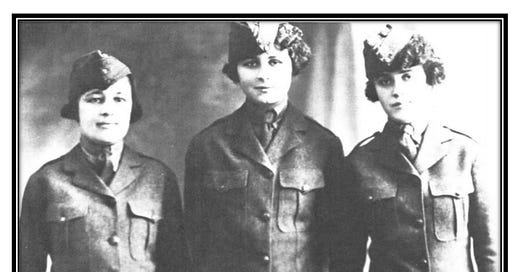TDIH: The first female Marine
The news spread like wildfire: The Marines were recruiting women to help in the war effort!
On this day in 1955, Opha May Johnson passes away. She is best known as the first woman to enroll in the United State Marine Corps. The country was then in the midst of World War I.
Marine Commandant Major General George Barnett needed more men overseas, but some were stuck in the States doing clerical work instead. Could women be recruited to do the job?
Some were doubtful. Nevertheless, on August 2, 1918, General Barnett wrote a letter to the Secretary of the Navy, asking for authority to proceed. The Navy had already invited women to join its ranks, so Barnett’s request was quickly approved. The news spread like wildfire: The Marines were recruiting women to help in the war effort!
When recruiting offices opened on August 13, long lines of women were waiting, but Opha May Johnson would be the first to enroll. She was already working at the Marine Corps Headquarters as a civil service employee.
Meanwhile, other women clamored for the opportunity to join her. The Marines were looking for women of good character between the ages of 18 and 40. They needed business or office experience, and they had to pass a physical examination, just as the men did. Applicants were to provide letters of recommendation.
One woman described what it was like in the recruiting stations:
“Male noncommissioned officers went up and down the line asking questions about experiences, family responsibilities, etc.,” she described, “and by the process of elimination got the line down to a few hundred.”
Applicants then went through an additional interview, as well as stenographic, shorthand, and typing tests.
One potential recruit failed the typing test, but she decided to try again the next day. “I did my hair differently and dressed differently,” she later described. “I thought I might be recognized, and I was. The amazed Colonel said, ‘Weren’t you here yesterday?’ I remember hesitating, and when I said, ‘Yes, I was,’ he got up and leaned over the desk and shook my hand and said ‘That’s the spirit that will lick the Germans! I will allow you to take the test again.’”
This time, she passed the test with flying colors.
Another recruit would write her fiancé in France, telling him what she’d done. “I know it’ll be hard at first, but it’ll grow on you after a while,” Private Martha Wilchinski told her fiancé. “Are you ready? Well, then,—I’m a lady leatherneck; I’m the last word in Hun hunters; I’m a real, live, honest-to-goodness Marine! The process was painful, I admit, and lasted for thirty-six hours, but I survived it all right.”
The Marines, being Marines, had strict requirements. Not everyone would make the cut.
“Among the thousands of women who burned with patriotic desire to serve the country as a woman reservist,” military historian Linda Hewitt concludes, “only a select few were able to meet the rigid requirements demanded by the Corps. In all, only 305 were enrolled during the four months of recruiting. It was not unusual to find that out of 400 applicants only one had been chosen or that out of 2,000 only five were found to be qualified.”
Colonel Albert S. McLemore would call these Marines his “100% girls.”
Each woman entered service with the rank of private. They were mostly assigned to clerical duty, but they were also drilled each morning, just like the men. Likewise, they received the same pay as men of equal rank.
Maybe you won’t be surprised to hear that the women ultimately proved themselves more than up to the challenge of being Marines. They earned respect—and promotions.
For her part, Opha May Johnson had attained the rank of sergeant by the end of the war.
Semper Fi, Marines.
Sources can always be found on my website, here.





I am the proud daughter of 2 Marines in the 50’s , and Proudly born on Naval Marine Base Camp LeJeune, North Carolina🙏🏼🇺🇸🙏🏼🪖🙏🏼⛑🙏🏼🇺🇸🙏🏼🚓🙏🏼🚑🙏🏼🚒🙏🏼🇺🇸🙏🏼🚜🙏🏼🚛🙏🏼🇺🇸🙏🏼🗽🙏🏼🌎🙏🏼☮️🙏🏼🇺🇸Amen
Hats Off and a Salute to All Lady Marines-Past and Present!